A large-scale study comparing two protocols for stimulating the ovaries in IVF has found that one has a lower risk of ovarian hyperstimulation syndrome (OHSS), a potentially serious complication of IVF treatment.
Ovarian stimulation is part of an IVF cycle – it allows multiple eggs to mature and be collected at once, rather than a single egg which is normally released during a natural cycle. In order to accomplish this, the natural ovulation cycle needs to be paused and two different protocols can be used – the 'long agonist protocol' or the newer 'short antagonist protocol'.
Dr Pedro Melo from the Tommy's National Centre for Miscarriage Research at the University of Birmingham presented results at the annual meeting of the European Society of Human Reproduction and Embryology comparing the protocols in terms of live birth rates achieved as well as risk of OHSS.
'We can now say with a good level of confidence that in patients with predicted high or normal response [to ovarian stimulation], using long protocols is unlikely to improve their live birth rates but will probably increase their risk of OHSS', he said.
OHSS is a common complication of IVF, affecting up to a third of patients. Symptoms include enlarged ovaries, abdominal pain and bloating, but in around one percent this condition can progress to a more severe form which can affect the circulation, lungs and kidneys and can occasionally be life threatening.
OHSS is known to be more likely in women who are predicted to have a normal or high response to ovarian stimulation, based on hormone levels and an ultrasound of the ovaries. For these women, the risk of OHSS was reduced by 52 percent, when the short protocol was used.
The findings come from a meta-analysis of 171 randomised trials, incorporating almost 37,000 patients carried out by the Cochrane group.
'This meta-analysis confirms what we have known for some time - the GnRH antagonist protocol is safer for women undergoing IVF, while being equally effective and more convenient for patients than the GnRH agonist protocol,' Dr Raj Mathur, chair of the British Fertility Society and consultant gynaecologist at Saint Mary's Hospital, Manchester told BioNews. He was not involved in the study. 'UK clinicians have been prompt in adopting this innovation, which combined with an altered trigger can significantly reduce the risk of OHSS.'




Leave a Reply
You must be logged in to post a comment.